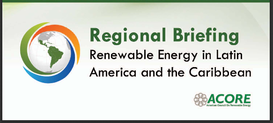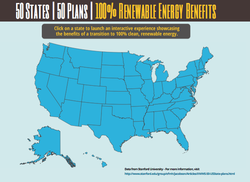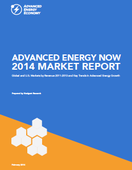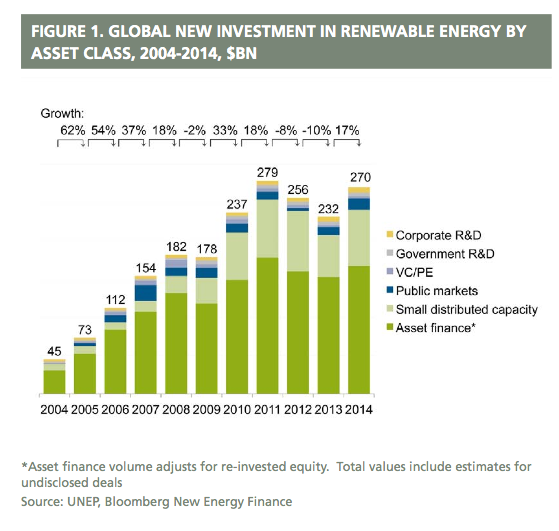
|
|
|
Renewable energy investment surged 17% to $270 billion in 2014. Further, the world added 103GW of new renewable power capacity (excluding large hydro), and renewable energy technologies made up 48% of net power capacity added globally, according to Global Trends in Renewable Energy Investments 2015, a new report prepared by the Frankfurt School-UNEP Collaborating Centre for Climate & Sustainable Energy Finance, the United Nations Environment Programme (UNEP) and Bloomberg New Energy Finance.
 Effective August 12, 2014, Mexico's new electricity law opened the electric industry to private sector participation in generation, transmission, distribution and power marketing activities. The new law provides for mechanisms to encourage the use of clean energy sources, and generation companies that produce energy through renewable sources or clean technologies will be eligible to receive tradable clean energy certificates. Legal analyses are available here and here. Analysis by Bloomberg New Energy Finance shows that investment in clean energy in Mexico totalled $1.3 billion in the first half of 2014, compared to $1.6 billion in the whole of last year. If activity continues at the rate of the first six months, then 2014 will be a record year, overtaking the previous high of $2.4 billion set in 2010. Significant further increases in activity in both wind and solar are forecast in the next two years.  Caribbean nations are looking to attract as much as $30 billion of investment to expand the clean power sector and cut reliance on fossil fuels, according to the Caribbean Development Bank. “Most of our countries are highly dependent on fossil fuels for power generation,” Caribbean Development Bank president Warren Smith said in an interview to Bloomberg News in London. “This vulnerability to volatile oil prices has contributed hugely to the competitiveness challenges of Caribbean industries.” About $20 billion is needed in the next five to 10 years to replace power plants and upgrade distribution and transmission, he said. There is potential to replace 4,750MW of fossil-fuel generation with renewables through 2019, Smith said. The bank is talking with regional utilities interested in building clean energy plants to feed power into the grid. Smith also noted that the region is starting from a very low level of renewables deployment and needs policy support from governments if it is to realize this clean energy vision. For example, only two countries - Jamaica and Barbados - currently allow households and businesses generating their own power through technologies such as solar panels to sell it back to the grid, leading to a policy gap that acts as a barrier to wider investment. "The regulatory environment is a prerequisite for a major uptake of renewables," Smith says. "If you want to move to a situation where you can attract investment in renewable then you have to have the ability to sell to the grid. Right now, we are behind the eight-ball on that. But we are working with the countries to try to ensure that legislation is put in place." Sources for this post: Bloomberg New Energy Finance Week in Review; Business Green.  ACORE's white paper, “Renewable Energy in Latin America and the Caribbean,” analyzes issues and opportunities in the Latin American and the Caribbean (LAC) region's renewable energy markets. New sources of renewable energy funding are increasingly available, according to the White Paper. Sources include local and multinational development banks such as the Inter‐American Development Bank (IDB), Brazilian Development Bank (BNDES), and Overseas Private Investment Corporation (OPIC), as well as foreign and local private investors. These positive signals indicate that the LAC region will continue to be an important location for renewable energy investment and deployment in the years to come.  Clean Edge this week released its annual Clean Energy Trends 2014 report (download for free here), which includes tracking, forecasting and market sizing of the global solar, wind, and biofuels markets, analysis on solar PV pricing, public market performance, venture capital investments, and energy capacity additions. For 2014 the report also features global figures for LEED buildings and EV/hybrid vehicles. The authors highlight the following as five key trends to watch:
 In a detailed study of 245 dams in 65 countries, researchers with the University of Oxford found that cost overruns averaged 96% and schedule slippage averaged 44%. The study found overwhelming evidence that energy planners systematically underestimate the actual costs and implementation schedules of large hydropower dams. The larger the dam, the longer the implementation schedule and the higher the cost overrun. As a result, even before accounting for negative impacts on human society and environment, and without including the effects of inflation and debt servicing, the actual construction costs of large dams are too high to yield a positive return; including these items, costs and cost overruns are much higher. Since large dams take inordinately long periods of time to build, they are ineffective in resolving urgent energy crisis. Applying this forecasting analysis to large dam projects in the planning and construction stages, such as Brazil's Belo Monte, the authors warn that such projects are likely to face large cost and schedule overruns that seriously undermine their economic viability. The study was published in the March 2014 issue of Energy Policy. Studies Highlight Benefits of Renewable Power and Energy Storage for Latin America and Caribbean3/20/2014
 Two recent technical papers published by the InterAmerican Development Bank highlight the economic and societal benefits of renewable energy and energy storage technologies to Latin America and the Caribbean: Societal Benefits from Renewable Energy in Latin America and the Caribbean and Potential for Energy Storage in Combination with Renewable Energy in Latin America and the Caribbean.  In 2013, the US added nearly twice as much solar generation capacity as coal—2,936 MW of solar compared to 1,543 MW of coal—according to data from the Federal Energy Regulatory Commission.  Based on data from Stanford University, a new study presents roadmaps for each of the 50 United States to convert their all-purpose energy infrastructure(for electricity, transportation, heating/cooling, industry) to ones derived entirely from wind, water, and solar (WWS) power generating electricity and electrolytic hydrogen after energy efficiency measures are accounted for. The numbers of devices, footprint and spacing areas,energy costs, numbers of jobs, air pollution and climate benefits, and policies needed forthe conversions are provided for each state. The plans contemplate all new energy powered with WWS by 2020, about 80-85% of existing energy replaced by 2030,and 100% replaced by 2050.  The Advanced Energy Now 2014 Market Report is the first annual report of market size, by revenue, of the advanced energy industry, worldwide and in the United States. As defined by Advanced Energy Economy (AEE), a national association of business leaders with the goal of making the global energy system more secure, clean, and affordable, advanced energy is a broad range of technologies, products, and services that constitute the best available technologies for meeting energy needs today and tomorrow. Prepared for AEE by Navigant Research, Advanced Energy Now 2014 reports that, for 2013, advanced energy reached $1.13 trillion in estimated global revenue, a 7% increase year-over-year driven by growth in six of the seven segments. Fluctuation in the worldwide total for advanced energy was largely driven by a peak year for large hydro projects in 2011 followed by a large decline in 2012, then slow growth in 2013. In the United States, the advanced energy market was an estimated $168.9 billion in 2013, 15% of the global advanced energy market, up from 11% in 2011. Excluding wind, U.S. advanced energy revenue grew 18% from 2011 to 2012 and 14% from 2012 to 2013. Wind energy suffered a severe, $23 billion revenue downward swing between 2012 and 2013, due to policy uncertainty around the federal Production Tax Credit (PTC). The effect of wind’s downturn is that U.S. advanced energy revenue declined 2% overall in 2013, following a 26% increase from 2011 to 2012. |
Categories
All
Archives
January 2025
Blogroll
|
|
© 2013 - 2025 InterAmerican Clean Energy Institute, a project of Earth Ways Foundation Inc, a 501(c)3 nonprofit organization.
|
Web Hosting by iPage
|

 RSS Feed
RSS Feed